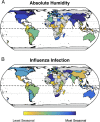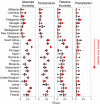Global environmental drivers of influenza
- PMID: 27799563
- PMCID: PMC5135382
- DOI: 10.1073/pnas.1607747113
Global environmental drivers of influenza
Abstract
In temperate countries, influenza outbreaks are well correlated to seasonal changes in temperature and absolute humidity. However, tropical countries have much weaker annual climate cycles, and outbreaks show less seasonality and are more difficult to explain with environmental correlations. Here, we use convergent cross mapping, a robust test for causality that does not require correlation, to test alternative hypotheses about the global environmental drivers of influenza outbreaks from country-level epidemic time series. By moving beyond correlation, we show that despite the apparent differences in outbreak patterns between temperate and tropical countries, absolute humidity and, to a lesser extent, temperature drive influenza outbreaks globally. We also find a hypothesized U-shaped relationship between absolute humidity and influenza that is predicted by theory and experiment, but hitherto has not been documented at the population level. The balance between positive and negative effects of absolute humidity appears to be mediated by temperature, and the analysis reveals a key threshold around 75 °F. The results indicate a unified explanation for environmental drivers of influenza that applies globally.
Keywords: empirical dynamic modeling; epidemiology; nonlinear dynamics; physical–biological coupling; state-dependence.
Conflict of interest statement
The authors declare no conflict of interest.
Figures






Comment in
-
Timing and periodicity of influenza epidemics.Proc Natl Acad Sci U S A. 2016 Nov 15;113(46):12899-12901. doi: 10.1073/pnas.1616052113. Epub 2016 Nov 3. Proc Natl Acad Sci U S A. 2016. PMID: 27810955 Free PMC article. No abstract available.
-
Reply to Baskerville and Cobey: Misconceptions about causation with synchrony and seasonal drivers.Proc Natl Acad Sci U S A. 2017 Mar 21;114(12):E2272-E2274. doi: 10.1073/pnas.1700998114. Epub 2017 Mar 15. Proc Natl Acad Sci U S A. 2017. PMID: 28298533 Free PMC article. No abstract available.
-
Does influenza drive absolute humidity?Proc Natl Acad Sci U S A. 2017 Mar 21;114(12):E2270-E2271. doi: 10.1073/pnas.1700369114. Epub 2017 Mar 15. Proc Natl Acad Sci U S A. 2017. PMID: 28298534 Free PMC article. No abstract available.
References
-
- Xie X, Li Y, Chwang ATY, Ho PL, Seto WH. How far droplets can move in indoor environments--Revisiting the Wells evaporation-falling curve. Indoor Air. 2007;17(3):211–225. - PubMed
MeSH terms
LinkOut - more resources
Full Text Sources
Other Literature Sources
Medical

